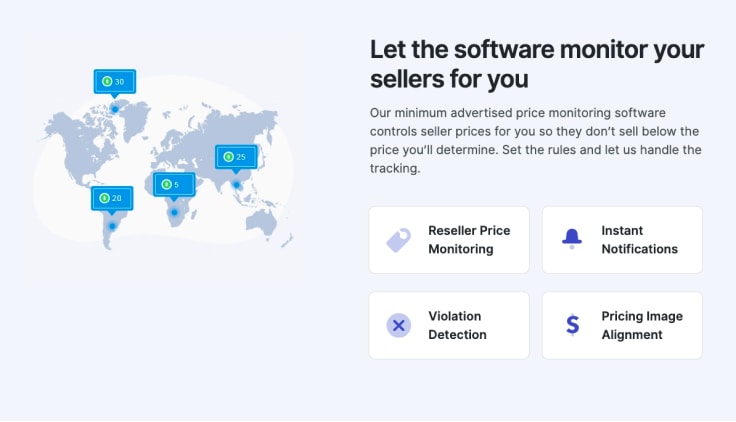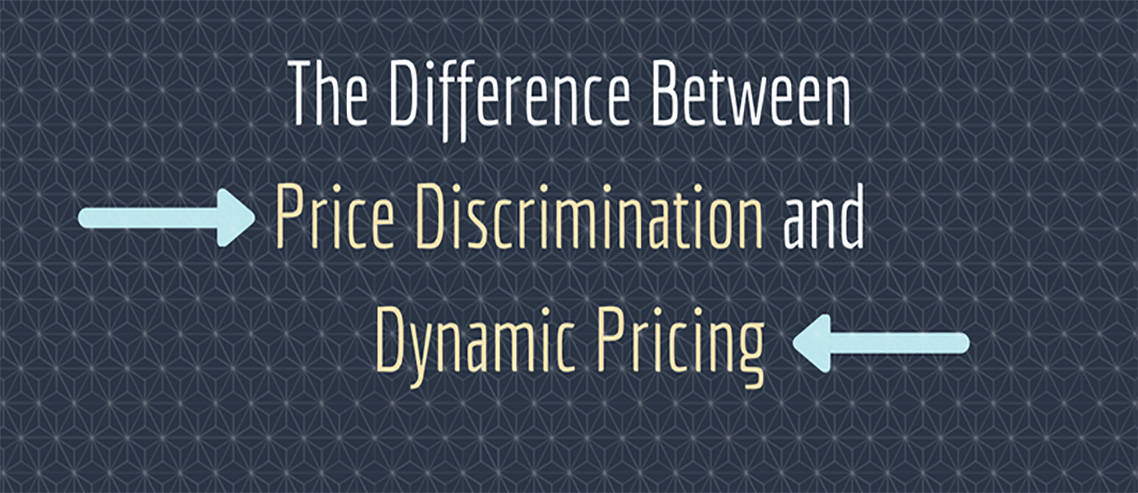Estimated reading time: 11 minutes
Table of contents
Although many companies, including retailers, consider price management an easy task, pricing strategies are complex because they involve various stages, from production costs, product price setting, and consumer attitudes. Choosing a pricing policy depends on numerous factors, including how much your product appeals to customers and whether you can cover the costs.
A unilateral pricing policy (UPP) is an integral part of dynamic pricing that allows a company to announce a minimum resale price without making any agreements or negotiations with resellers. Under the UPP, the company does not make sales to resellers if they sell below the price announced by the company. In today’s article, we will discuss the UPP, its importance, and how Minimum Advertised Price (MAP) policy can help you enforce it.
The Importance of Unilateral Pricing Policy
Unilateral Pricing Policy allows the manufacturing company to fix the prices of the products, and this policy prohibits vendors from offering discounts, incentives, or rebates to retail consumers. Brick and mortar and online retail that work with the company must adhere to the policy. Most companies pride themselves on offering quality products for the best prices.
These retailers offer products on their websites with UPP restrictions and at the lowest price set by the manufacturer. The purpose is to motivate their customers that they have the lowest-price products. Because products that fall under this policy are already at the lowest price, the retail company does not offer discounts and coupons that reduce the cost of their products.
Because a UPP policy allows you to announce a minimum acceptable price for your products, we believe it is much better than MAP because you have everything in place and streamlined. It also enables you to do business with any reseller that agrees to sell your products according to the policy.
A Unilateral Pricing Policy allows you to control the retail price of your products and prevent you from violating the antitrust law, particularly for anti-competitive behavior. In addition, a UPP policy is powerful enough to stop resellers from setting their own prices for your products.
Many resale channels or retailers think that a UPP policy is not suitable for their business operations. However, this is not the case, and we believe this is none other than a misconception. The reason is that a UPP policy protects resale channels or retains from undergoing shady operations, allowing them to provide their customers with high-quality products at prices suitable for both of them. Here are some of the critical features of UPP.
One-Way Policy
UPP is a one-way policy, meaning it does not involve agreements or negotiations between the manufacturing companies and resellers. The one-way policy is a unique characteristic or feature of UPP, allowing manufacturing companies and resellers to stay independent. So, this makes a UPP safer and securer legally because the price is set by the manufacturing company, leading to reduced confusion or red flags.
Advertised and Resale Prices
One of the best characteristics of a UPP is that it covers the resellers’ advertised and actual resale prices. The primary benefit of protecting these two prices is to ensure no confusion between the manufacturing company and reseller. A UPP policy mitigates the challenges of aligning advertised price and resale price.
No Antitrust Risk
As the name indicates, unilateral or UPP does not involve agreements or negotiations with resellers, leading to better relationships and trust between the manufacturing companies and resellers. A UPP does not include punishment for the violator, unlike a MAP policy. Therefore, a UPP enables you to mitigate the risk of antitrust and streamline your business processes.
What is Minimum Advertised Price (MAP)?
Many manufacturing companies and brand owners develop a MAP policy because they believe that it can optimize different processes, including how their resale channels advertise and sell their products. However, a MAP policy may not align with your company’s specific case, and you have to opt for another policy such as a UPP.
MAP stands for minimum advertised price policy that focuses on describing reseller policy. Because there are numerous forms of price management or pricing policies available to manufacturing companies and brands, MAP may not align with their business goals, allowing them to choose a policy that best fits their needs.
A MAP policy allows resellers to agree or negotiate to know the lowest prices the manufacturing company will allow them to advertise their products. Before we discuss how MAP can help you enforce Unilateral Pricing Policy, let us highlight some of the key features of MAP policy. Continue reading!
Resellers have Freedom
A MAP policy does not set a limit on the actual price of the products. However, it defined limitations on the products’ prices a reseller may advertise. Thus, this type of policy allows resellers to have greater freedom and remain free to sell the manufacturing company’s products at the prices they choose.
Bilateral Agreement
Unilateral Pricing Policy and MAP policies work antagonistically against each other because the former does not involve agreements, and the latter focuses on agreements or negotiations between the manufacturers and resellers.
Bear in mind that a MAP policy focuses on a bilateral agreement. However, sometimes, they are written as contracts and signed by the manufacturing company and reseller. Thus, a MAP policy may offer a win-win situation, but this is not always true.
Cooperative Advertising Funds
Companies use MAP policies because they are a two-agree agreements where the manufacturing companies offer advertising funds to retailers. As a result, retailers or resellers must adhere to the manufacturing company’s MAP pricing, leading to various complications.
Because a MAP policy focuses on cooperative advertising funds or dollars, resellers must comply with the manufacturers. Otherwise, the company will withhold the advertising funds from the retailer. The problem occurs when a retailer fails to advertise the manufacturing company’s product below the agreed MAP levels.
Why is a MAP Policy not Suitable for some Companies?
MAP policies have numerous limitations, making them unsuitable for many manufacturing companies and brands. For instance, if you have a manufacturing company and don’t offer cooperative ad funding to the reseller, this type of policy will lead to severe consequences.
Therefore, it is crucial to avoid a MAP policy if you don’t offer cooperative advertising dollars to resellers. Sometimes, manufacturers undergo a significant problem of resale-price erosion with resellers. For example, if your resale channels do not sell your products for prices that don’t align with the advertised prices, it can significantly impact your company’s bottom line.
The reason is that a MAP policy does not allow you to dictate your resale channels and encourage them to sell your products for the advertised price. So, this is where you need a UPP policy for your company to streamline the entire process and achieve your goals.
According to U.S laws, advertising refers to stopping at a retailer’s front door, meaning the products’ prices within the store’s walls, price tags, signage, and discounts, are “resale prices” and not ad prices.
For instance, when a customer visits the store or retail shop, and he/she is inside the premises, the retail company won’t advertise to them. Instead, the retailer will sell the products to the customers to earn profits.
What does this mean? It means when the customers are at the store’s front, you are advertising to them, but when they enter the store, you no longer advertise to them and only focus on selling the products.
How to Implement a Unilateral Pricing Policy?
Unlike MAP policies, Unilateral Pricing Policies are highly effective when the manufacturers follow a step-by-step approach to implement them. Some companies implement a UPP policy and expect to achieve good results. However, they fail to achieve their goals and desired outcomes due to a lack of proper planning, drafting, implementing, enforcing, and monitoring strategies.
Although the process of implementing a UPP policy seems daunting and time-consuming, if you plan, draft, implement, monitor, and enforce it correctly, you can streamline the procedure. We recommend seeking help from professionals with expertise in planning and executing a Unilateral Pricing Policy. Remember, this is a one-time investment because planning and drafting are not long-term or ongoing endeavors.
On the other hand, you will continually require business and legal support to monitor and enforce your UPP policy. The reason is that these two areas are ongoing endeavors, requiring you to use third-party services that help with the enforcement or alert you of violations. Here is how you can successfully implement a UPP policy.
- Create a Solid Plan
When you have a famous brand, your resale channels will demand providing discounts to its customers. For example, if you manufacturer baby products, your resale channel will want to sell them for a discounted price to attract more customers.
So, it is crucial to create a plan and implement a robust pricing policy if you have a valuable brand. However, if your resale channel does not value your company, your policy won’t make a lot of difference. It is because the retailer does not worry about even if you cut off the supply of products.
Do you remember when a small brand, Birkenstock, challenged the big giant “Amazon” about its negligence toward unauthorized resellers? There were many unauthorized resellers on Amazon, and the most popular online company did not focus on stopping them. That’s why Birkenstock encouraged their authorized sellers to stop selling the products on Amazon. However, many unauthorized resellers on Amazon still sell Birkenstock products.
Anyway, once you have determined that the policy will work for your company, make sure all internal stakeholders follow the policy and focus on long-term goals to preserve your brand’s equity and maintain different resellers. Although these are excellent objectives for your company, they may lead to clashes or conflicts with short-term profit goals and cause complications for volume-based sales-force structures.
The problem occurs when you enforce the policy and cut off violators that are valuable to your company. Therefore, when planning for the policy, make sure everyone in your company, including finance, accounting, marketing, and sales, shows commitment to the policy and makes efforts to get the most out of it. - Implement Your Unilateral Pricing Policy
Once you have crafted a UPP policy, it is time to implement it, but we recommend communicating it to resellers before you do this. That way, you can reinforce the policy better. On the other hand, if your resale channel does not know about your UPP policy or has confusion about it, your policy won’t work, causing a wide range of complications.
That’s why it is crucial to follow a step-by-step approach when transitioning from the planning stage to the execution or implementation stage. Experts recommend manufacturing companies to use UPP policies because they allow manufacturers to create an agreement that focuses on fixed prices.
Avoid mistakes during the implementation stage because it can lead to severe consequences. For instance, if you fail to state in the agreement that your resale channel must follow your brand’s policy, you won’t achieve your goals of pricing strategies.
That’s why we recommend exclusively crafting a pricing policy and clearly mentioning that the resale channel must comply with it. That way, you can avoid so many complications. Make sure you appoint a well-informed policy administrator to address all resellers’ queries and concerns.
The purpose is to decrease the risk of inadvertent agreements. Your policy administrator will have all the rights, authority, and autonomy, leading to streamlined communication between the internal policy committee and resale channels or retail companies.
The purpose is to ensure consistent communication, collaboration, interpretation, and enforcement. At the same time, employing a policy administrator helps you avoid one-on-one discussions on pricing between a sales rep and a loyal client, causing the agent to offer the buyer a deal.
So, if you want to avoid such a situation, make sure you have a policy administrator. The purpose is to mitigate the risk of troublesome agreement on prices. It is crucial to keep apart your sales personnel and resellers on resale pricing because sales force incentives and policy requirements may not align with each other. Remember, your salespeople do not need to police your policy, and their job is to sell.
Final Words
Many manufacturing companies and brands confuse a UPP policy with a MAP policy. At the same time, they don’t know which policy will work best for their respective brands. Some companies even copy a MAP policy agreement from the internet and represent it as a UPP policy. Next, they publish a pricing statement, which is a violation of the antitrust law.
We recommend hiring a brand protection expert to help you identify these problems and find a more effective and optimal reseller pricing policy for your manufacturing company. Likewise, you must perform thorough research and gain enough information to craft a policy that works best for your company.
For instance, if your company offers cooperative ad funds to your resale channels, we recommend choosing and implement a MAP policy. Likewise, if you have identified problems with advertising prices for your products, we advise implementing a MAP policy.
On the other hand, if you don’t feel comfortable putting pricing policy into an agreement and want to reduce legal risks, craft a UPP policy. You also need a UPP policy if you want autonomy to change your pricing policy without informing your resale channel or update agreements with it when you make changes.
Moreover, if you want to protect your brand from the problem of advertised and sale prices, make sure you craft and implement a UPP policy. Having such a policy allows you to protect your manufacturing company from the erosion of prices in advertised and resale categories.
pricing strategies



Leave a Reply